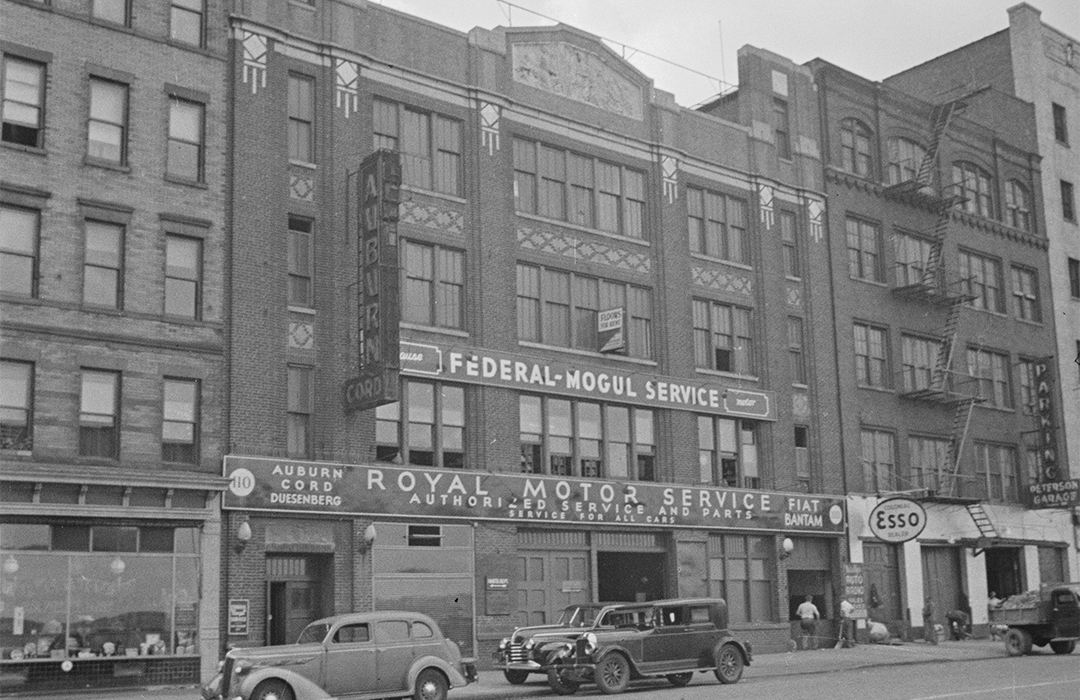
110-114 West End Avenue
by Tom Miller
In 1914, Thomas Campbell hired architects J. J. Lawlor and Erwin Rossbach to enlarge his stable at 114 West End Avenue by adding a second story. It appears that before work could be started, however, Louis Richard gave him a better offer. Richard purchased the vintage stable, demolished it, and commissioned architect Elliot J. Lynch to design a modern garage on the site. On April 17, 1915, before ground was broken, the Record & Guide reported that he had leased “the four-story garage to be erected…at 110-114 West End av.” to G. Pellette.
Completed within the year, Lynch had designed the garage in the Arts & Crafts style, its red brick façade highlighted by brightly colored tiles and creatively laid brickwork. Embedded in the prominent parapet was a large bas-relief sculpture.
by 1917, the firm had branched out into airplane parts.
Pellette sublet space in the garage to the Walton Body Company, Inc. in 1916. The firm manufactured custom-made bodies for Hudson, National, Mitchell, Cadillac, Chandler, Paige-Detroit, and Packard automobiles. Surprisingly, by 1917, the firm had branched out into airplane parts. An advertisement in the August 6 edition of Aerial Ace Weekly that year noted:
We are prepared to make prompt delivery of Airplane Parts including the following: small wooden parts—such as ribs, struts, beams, etc., also sheet aluminum work and copper tanks.
On August 7, 1919, The New York Times reported that the G. Pellette Garage, Inc. had filed for bankruptcy. Louis Richard was quick to place an advertisement in the same newspaper offering the “4 story and basement” garage for rent at “very reasonable and easy terms.” It was leased by a man named Suartullo, who advertised, “Men wanted: All-around automobile machinists and repair men; only men of best calibre apply; repair men to apply must have a good Packard and Cadillac experience.”
But like Pellette, his venture did not work out. In April 1921 Louis Richard was once again advertising the building for lease. His new tenant was the Roberts Brothers Auto Painting and Trimming Company. Unknown to Richard, most likely, the owners had additional ways to earn money.
On February 11, 1922, the New York Herald reported that Federal agents Galante and Strauss had raided 114 West End Avenue “and discovered a thirty gallon still, some mash and moonshine. They arrested one proprietor and left a summons for the other.”
Federal agents Galante and Strauss had raided 114 West End Avenue
The run-in with Prohibition agents seems to have ended the Roberts Brothers’ operation here. In the late 1920s, the New York Triplex Safety Glass Co. (which sold windshield glass “that will not shatter”) shared the building with the Economical Auto Refinishing Co., Inc. And by the early 1940s the Royal Motor Service company occupied the building.
The long tradition of auto repairs came to an end in 1976. The San Juan Hill neighborhood was experiencing sweeping urban renewal, and that year the block was demolished to make way for a seven-story apartment house.
Tom Miller is a social historian and blogger at daytoninmanhattan.blogspot.com


